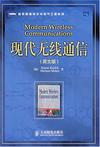现代无线通信
2007-2
人民邮电
(加)赫金,(加)默尔 著
478
595000
无
无线通信及其应用已经成为当今信息科学技术最活跃的领域之一。本书是针对通信系统课程教学而撰写的一部新作,在阐述方式和取材方面都颇具特色。书中主要针对无线网络的物理层,阐述了无线电传播基础和现代无线通信基本理论及技术。全书内容共分为7章、9个附录,分别介绍调制、编码、扩频等问题;每一章都有例题及详解,并在章末配有大量习题,以帮助读者理解本章所讨论内容。 本书适合作为高等院校通信和电子工程相关专业高年级本科生和研究生教材,同时也可供工程技术人员参考。
Simon Haykin是国际电子电气工程界的著名学者,加拿大皇家学会院士,IEEE会士,于1953年获得英国伯明翰大学博士学位,现任加拿大麦克马斯特大学教授,在该校创办了通信研究实验室并长期担任主任。他曾经获得IEEE McNaughton奖章,在神经网络、通信、自适应滤波器等领域成
Chapter 1 Introduction 1.1 Background 1.2 Communication Systems 1.3 The Physical Layer 1.4 The Data-Link Layer 1.5 Overview of the Book Notes and References Chapter 2 Propagation and Noise 2.1 Introduction 2.2 Free-Space Propagation 2.3 Terrestrial Propagation: Physical Models 2.4 Terrestrial Propagation: Statistical Models 2.5 Indoor Propagation 2.6 Local Propagation Effects with Mobile Radio 2.7 Channel Classification 2.8 Noise and Interference 2.10 Theme Example 1: Okumura-Hata Empirical Model 2.11 Theme Example 2: Wireless Local Area Networks 2.12 Theme Example 3: Impulse Radio and Ultra-Wideband 2.13 Summary and Discussion Notes and References Additional Problems Chapter 3 Modulation and Frequency-Division Multiple Access 3.1 Introduction 3.2 Modulation 3.3 Linear Modulation Techniques 3.4 Pulse Shaping 3.5 Complex Representation of Linear Modulated Signals and Band-Pass Systems 3.6 Signal-Space Representation of Digitally Modulated Signals 3.7 Nonlinear Modulation Techniques 3.8 Frequency-Division Multiple Access 3.9 Two Practical Issues of Concern 3.10 Comparison of Modulation Strategies for Wireless Communications 3.11 Channel Estimation and Tracking 3.12 Receiver Performance: Bit Error Rate 3.13 Theme Example 1: Orthogonal Frequency-Division Multiplexing 3.14 Theme Example 2: Cordless Telecommunications 3.15 Summary and Discussion Notes and References Additional Problems Chapter 4 Coding and Time-Division Multiple Access 4.1 Introduction 4.2 Sampling 4.3 Why Follow Sampling with Coding? 4.4 Shannon's Information Theory 4.5 Speech Coding 4.6 Error-Control Coding 4.7 Convolutional Codes 4.8 Maximum-Likelihood Decoding of Convolutional Codes 4.9 The Viterbi Algorithm 4.10 Interleaving 4.11 Noise Performance of Convolutional Codes 4.12 Turbo Codes 4.13 Comparison of Channel-Coding Strategies for Wireless Communications 4.14 RF Modulation Revisited 4.15 Baseband Processing for Channel Estimation and Equalization 4.16 Time-Division Multiple Access 4.17 Theme Example 1: GSM 4.18 Theme Example 2: Joint Equalization and Decoding 4.19 Theme Example 3: Random-Access Techniques 4.20 Summary and Discussion Notes and References Additional Problems Chapter 5 Spread Spectrum and Code-Division Multiple Access 5.1 Introduction 5.2 Direct-Sequence Modulation 5.3 Spreading Codes 5.4 The Advantages of CDMA for Wireless 5.5 Code Synchronization 5.6 Channel Estimation 5.7 Power Control: The Near-Far Problem 5.8 FEC Coding and CDMA 5.9 Multiuser Detection 5.10 CDMA in a Cellular Environment 5.11 Frequency-Hopped Spread Spectrum 5.12 Theme Example 1: IS-95 5.13 Theme Example 2: GPSS 5.14 Theme Example 3: Bluetooth 5.15 Theme Example 4: WCDMA 5.16 Theme Example 5: Wi-Fi 5.17 Summary and Discussion Notes and References Additional Problems Chapter 6 Diversity, Capacity, and Space-Division Multiple Access 6.1 Introduction 6.2 "Space Diversity on Receive" Techniques 6.3 Multiple-Input, Multiple-Output Antenna Systems 6.4 MIMO Capacity for Channel Known at the Receiver 6.5 Singular-Value Decomposition of the Channel Matrix 6.6 Space-Time Codes for MIMO Wireless Communications 6.7 Differential Space-Time Block Codes 6.8 Space-Division Multiple Access and Smart Antennas 6.9 Theme Example 1: BLAST Architectures 6.10 Theme Example 2: Diversity, Space-Time Block Codes, and V-BLAST 6.11 Theme Example 3: Keyhole Channels 6.12 Summary and Discussion Notes and References Additional Problems Chapter 7 Wireless Architectures 7.1 Introduction 7.2 Comparison of Multiple-Access Strategies 7.3 OSI Reference Model 7.4 The OSI Model and Wireless Communications 7.5 MAC Sublayer Signaling and Protocols 7.6 Power Control 7.7 Handover 7.8 Network Layer 7.9 Theme Example 1: Wireless Telephone Network Standards 7.10 Theme Example 2: Wireless Data Network Standards 7.11 Theme Example 3: IEEE 80 2.11 MAC 7.12 Summary and Discussion Appendix A Fourier Theory Appendix B Bessel Functions Appendix C Random Variables and Random Processes Appendix D Matched Filters Appendix E Error Function Appendix F MAP Algorithm Appendix G Capacity of MIMO Links Appendix H Eigendecomposition Appendix I Adaptive Array Antennas Bibliography Index

无
是学习无线通信基础的好书!个人感觉适合于普通高校的通信工程专业研究生入门。
大牛S****Haykin的书是绝对值得收藏和阅读的。国外大牛写的书通俗易懂,深入浅出。不像国内的书,东凑西拼,东抄西拉,完全没有系统性。这类书建议看原版,现在翻译的专业书籍一向鄙视。除了老一辈人翻译的书,比如我上大学时用的教材“信号与系统”刘树堂译就不错。